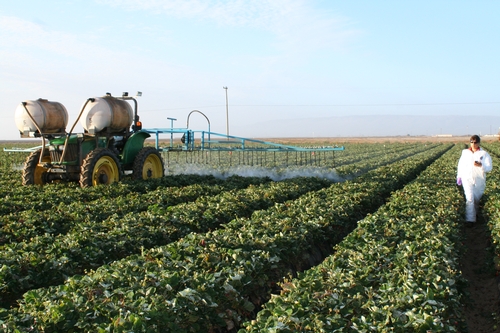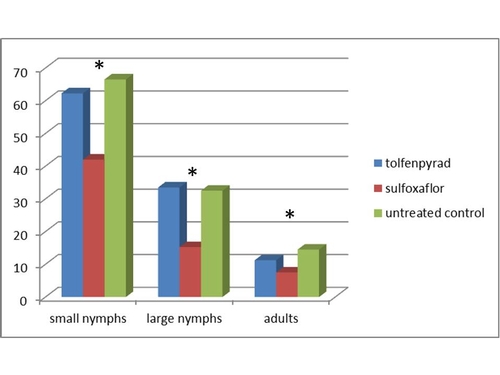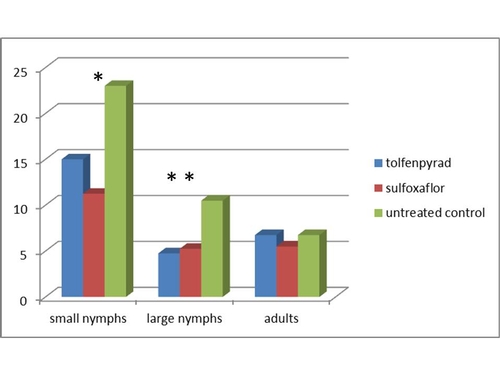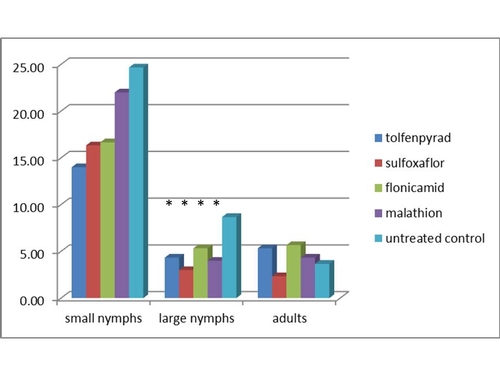Field efficacy of the experimental insecticides sulfoxaflor, tolfenpyrad and flonicamid for lygus bugs in strawberry.
Introduction: As noted previously in this blog, lygus bugs are a major pest in strawberries since they cause mis-shaping of fruit from their feeding on the early forming fruit. This pest has been a real challenge to California strawberry growers, one reason being that the populations in the Central Coast production regions have become quite tolerant or even resistant to many of the pesticides used for it.
Fortunately several promising insecticide chemistries for control of lygus bugs have become available for field trials over the past few years.
Please note that sulfoxaflor and tolfenpyrad are still NOT REGISTERED (flonicamid is) for use in strawberries.
Three large scale trials of up to a third of an acre per treatment were conducted this past year to test these three novel insecticides under real field conditions.
Application: One trial in a second year strawberry field in Salinas testing three materials (plus one grower standard) was conducted with a standard research backpack sprayer (applied 5/3/2012), another (overseen by the California Strawberry Commission) in a first year field in Guadalupe with a tractor mounted spray rig (applied 8/28/2012 and 9/12/2012), and a third in Watsonville with another tractor mounted spray rig (applied 10/5/2012 and 10/12/2012). Refer to the table below for rates of test material and water carrier.
|
Test Material (Brand Name) |
Trial 1 Salinas |
Trial 2 Guadalupe |
Trial 3 Watsonville |
|||
|
|
Water carrier Rate |
Test material Rate (formulated product) |
Water carrier Rate |
Test material Rate (formulated product)1 |
Water carrier Rate |
Test material Rate (formulated product)1 |
|
Untreated Control |
- |
- |
- |
- |
- |
- |
|
Sulfoxaflor (Closer) |
75 gal/A |
5.7 fl oz/A |
100 gal/A |
5.7 fl oz/A |
200 gal/A |
5.7 fl oz/A |
|
Tolfenpyrad (Bexar) |
75 gal/A |
27 fl oz/A |
100 gal/A |
27 fl oz/A |
200 gal/A |
27 fl oz/A |
|
Flonicamid (Beleaf) |
75 gal/A |
6.0 fl oz/A |
- |
- |
- |
- |
|
Malathion Aquamul |
75 gal/A |
2 pt/A |
- |
- |
- |
- |
1 Note that these materials were added with the surfactant Natural Wet at the rate of 8 fl oz/A.
Insect and Fruit Sampling: Lygus bugs were sampled by beating 20 strawberry plants (3 times each) in a row into an open plastic container and counting small nymphs, large nymphs and adults. Lygus bugs were sampled weekly for 6 weeks following the first spray application in Guadalupe, weekly for three weeks following the first application in Watsonville and weekly for four weeks following the application in Salinas. Fruit evaluation took place on 9/26/2012 and 10/10/2012 in Guadalupe and 10/19/2012 and 10/26/2012 in Watsonville. Fruit sampling consisted of randomly picking 50 fruit from the center two furrows of each trial. These picked fruit were graded into three categories; marketable, unmarketable due to lygus feeding (“catfacing”) and unmarketable due to other causes (mainly rots and small size).
Statistical analysis is a standard analysis of variance (ANOVA), using a square root or a logarithmic transformation in some instances in order to closer meet the assumptions of the statistical analysis .
Results and Discussion:The experimental sprays worked, especially the sulfoxaflor. Analysis by date show that sulfoxaflor treated plots in the Guadalupe and Watsonville trial were associated with lower numbers of adults, large nymphs and small nymphs on multiple dates after the initial application, and treated plots in Watsonville. Tolfenpyrad also did result in significant reduction in numbers of nymphs and adults on certain evaluation dates, particularly two weeks after the first application.
See Graphics 2-4 below for visual demonstration of evaluation results of lygus nymphs and adults 14 days after first pesticide application at each trial site.
The use of sulfoxaflor resulted in significantly higher amounts of marketable fruit than the untreated control on three sampling dates at both evaluation sites, while the use of tolfenpyrad resulted in significantly higher amounts of marketable fruit than the untreated control on two sampling dates at the trial site in Watsonville. Refer to Table 1 below for a summary of these results.
Table 1: Average marketable fruit yield for each sampling pick date for insecticide trials in Guadalupe and Watsonville, CA
|
Guadalupe |
||
|
Date |
Test Material |
Avg Marketable Fruit (out of 50)* |
|
9/26/2012 |
Sulfoxaflor (Closer) |
26.50 A |
|
|
Tolfenpyrad(Bexar) |
11.75 B |
|
|
Untreated |
8.25 C |
|
10/10/2012 |
Sulfoxaflor (Closer) |
14.50 A |
|
|
Tolfenpyrad(Bexar) |
3.25 B |
|
|
Untreated |
0.75 B |
|
Watsonville |
||
|
Date |
Test Material |
Avg Marketable Fruit (out of 50)* |
|
10/19/2012 |
Sulfoxaflor (Closer) |
14.50 A |
|
|
Tolfenpyrad(Bexar) |
10.50 B |
|
|
Untreated |
6.00 C |
|
10/26/2012 |
Sulfoxaflor (Closer) |
21.50 |
|
|
Tolfenpyrad(Bexar) |
27.25 |
|
|
Untreated |
25.00 |
*Letters indicate significant differences by post hoc analysis at p<0.05
Outside of malathion and flonicamid, the sulfoxaflor and tolfenpyrad are still NOT REGISTERED for use in strawberries. Before using any insecticide products, check with your local Agricultural Commissioner's Office and consult product labels for current status of product registration, restrictions, and use information.

Dr. Thomas confirming correct tractor speed for an experimental lygus insecticide application.

Graphic 2: Results 14 days after first application of experimental insecticide for lygus in Guadalupe 2012. *Indicates treatment was significantly lower than the untreated control.

Graphic 3: Results 14 days after first application of experimental insecticide for lygus in Watsonville 2012. *Indicates treatment was significantly lower than the untreated control.

Graphic 4: Results 14 days after first application of experimental insecticide for lygus in Salinas 2012. *Indicates treatment was significantly lower than the untreated control.
Comments:
Excellent question to which I have an answer and to which I will add even more. 6 oz per acre is what the sponsor asked us to do, and since the study was done previous to Beleaf getting a label in strawberries, it's a pretty sure bet 6 oz what they (FMC) intended but it went down in the regulatory process.
Likewise, having attended the research exchange with Dow this past Wednesday, it looks like the rate in strawberries for sulfoxaflor will be dropped by the EPA from 5.7 as we had in the study to 4.5 oz. Dow maintains that this shouldn't haven't a material effect on efficacy, but of course this is something which we will test.
So I asked Hillary Thomas about it, and here's what she writes:
"Both Sulfoxaflor and Tolfenpyrad have contact activity in addition to their primary modes of action, so under good coverage both should have some observable effects within 24-48 hours after application. I am not sure as to the duration of residual activity we can realistically expect under field conditions. We did not design our study to look at direct effects but I’m sure the companies have good data on this.
That being said, coverage, applications conditions such as weather and insect behavior patterns, the insecticide’s residual activity and any synergisms with other materials that they have been tank mixed with may increase or decrease time until results are observed.
Basically, they are not going to have a long delay like IGRs before the insect dies, but residual activity may cause additional mortality that has a larger population effect."


Posted by Will on March 1, 2013 at 7:25 AM